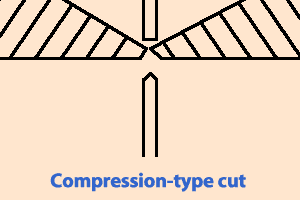|
Shear
Facts
Q1.
What is the difference between a stamped tool and a drop forged
tool?
A. Precision stamped Micro-Shear®
flush cutters have more in common with precision drop forged
tools than with conventional drop forged tools. Let us explain:
The most obvious difference
between drop forged and stamped tools is that the blank shape
of a drop forged tool is created from hot metal whereas a stamped
tool does not require heat at this stage. Beyond this point the
differentiation becomes less distinct.
In conventional drop
forging a crude, basic shape is created. With precision drop
forging a more refined shape with reference points for subsequent
grinding operations is created. Conventional drop forged tools
typically then undergo hand guided grinding operations. With
precision drop forged tools these grinding operations are usually
done with computer controlled machines utilizing the reference
marks on the blank.
When we manufacture precision
stamped Micro-Shear® flush cutters a refined shape, complete
with reference points for our computer controlled grinding operations,
is generated in the stamping process.
All tools, regardless
of the method of manufacture, have to be heat treated and in
the electronics industry return springs and cushion grips are
required. The distinction between drop forged and stamped tools
is further blurred since, due to the high density areas electronics
pliers are required to be able to work in, one of the more popular
head configurations on drop forged tools is the "relieved
head" On these tools additional grinding operations remove
additional head stock to reduce the tools profile, thereby increasing
access and maneuverability. The result of all this additional
work is a head shape very similar to the standard Xuron Micro-Shear®
flush cutter.
Q2.
What's the difference between a Micro-Shear® flush cutter
and a conventional wire cutter?
 A. The term Micro-Shear® flush
cutter is a registered trademark of Xuron Corporation and is
applied only to our products which utilize our patented, blade
by-pass shear cutting action. A. The term Micro-Shear® flush
cutter is a registered trademark of Xuron Corporation and is
applied only to our products which utilize our patented, blade
by-pass shear cutting action.
Conventional wire cutters
utilize a compression-type cut, with the advancing cutting edges
forcing the metal of the wire out of their way.
Micro-Shear® flush
cutters utilize a shearing cut, with the by-pass cutting edges
slicing cleanly through the metal (see illustration).
Shear cutting greatly
reduces mechanical shock delivered to the component and requires
only about half the effort to cut a wire as compared to conventional
compression type wire cutters.
Q3.
Why do Micro-Shear® flush cutters cut so well?
A. All primary cutting surfaces
on our 4" and 5" Micro-Shear® flush cutters are
generated on high precision, three microprocessor controlled,self
diagnostic grinding equipment. The grinding on every blade is
as precisely identical to that on every other blade as their
computer controlled tolerances allow. It is also exactly the
same type of grinding as used on such fine tools as LINDSTROM
and EREM .
We're not suggesting
any company use Xuron Micro-Shear® flush cutters instead
of these other great tools, but why should you sacrifice that
level of quality just because your requirements call for "popularly
priced" tools?
Q4.
Why do Micro-Shear® cutters last so long?
A. Xuron Micro-Shear® flush
cutters ensure durability by design. Let's use a little basic
physics to illustrate how:
If you generate 10 pounds
of pressure on the grips of a conventional, compression type
wire cutter to cut a wire, that 10 pounds of force must be dissipated
somewhere (Law of Conservation of Energy). Part of it is dissipated
into the severed section of wire, which is why it sails across
the room. A portion travels down the lead wire and is dissipated
into the component or solder joint, which is what the military
gets upset about. The balance is dissipated into the opposing
cutting edge of the cutter, which is why they get dull.
Using a Micro-Shear®
flush cutter requires only about half the pressure (approximately
5 pounds) to cut the same wire. Part of the force is dissipated
into the severed section of the wire, but if you are using our
patented lead retainer the wire won't sail across the room. Because
of our shearing cut, very little is dissipated into the component
or solder joint, which keeps the military happy and the rest
is dissipated into the opposing cutting jaw. Because of our blade
by-pass, edge to edge contact is eliminated and the life of our
Micro-Shear® flush cutter's precision cutting edges is extended.
|

